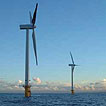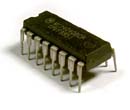|
Dynamic demand in 60 seconds |
|
|
| 0 seconds |
Dynamic Demand Control is a technology that could help stabilise the National Grid, reduce carbon dioxide emissions associated with power generation, and allow more intermittent renewable energy (like wind and solar power) than is currently possible. |
|
||||||||||||||||
| 5 seconds | The government has promised to connect significant amounts of renewable energy to the National Grid. | |||||||||||||||||
| 10 seconds | But many renewable sources are variable. Take wind: sometime it's windy sometimes it's calm. | |||||||||||||||||
| 15 seconds | Already the Grid has to be continually balanced because the demand fluctuates all the time (we randomly switch kettles, lights etc. on and off). | |||||||||||||||||
| 20 seconds | The National Grid company therefore has to pay for power stations to change their output continually on a second-to-second basis. This "response" service costs around £80 million a year (on top of the actual power supplied) and involves part-loaded generators which are less efficient. | |||||||||||||||||
| 25 seconds | An important question is: "What will happen when large amounts of intermittent renewables are on-line? How do we keep the system balanced?" This is an important issue for system operators and the Government. | |||||||||||||||||
| 30 seconds | But what if we could design appliances or heavy plant that demand most of their power at times when there is excess power available on the grid? | |||||||||||||||||
| 35 seconds | Take a fridge. It needs electricity of course. But it doesn't really care exactly when it gets it. Fridges have large thermal storage. | |||||||||||||||||
| 40 seconds | And the good news is that you can measure the excess power on the National Grid from any plug socket in the country. (You just measure the "50Hz" AC frequency because it drifts a little as generators slow down and speed up). See a real-time monitor of the grid frequency here. | |||||||||||||||||
| 45 seconds | The device you need to do this would cost less than £5 and would fit into a matchbox. | |||||||||||||||||
| 50 seconds | It should be possible to provide the same stabilising service to the National Grid more cost-effectively using dynamic demand fridges. This means such a fridge could earn money throughout its life. | |||||||||||||||||
| 55 seconds |
The organisation Dynamic Demand has been founded to promote this technology in as many electrical devices as possible. We want to see Government, regulators and industry seriously debate the possibilities. After all, if such a technology could reduce the carbon dioxide emissions associated with power transmission and allow more renewable energy onto the power grid, can we really afford not to have it? |
|||||||||||||||||
|
<< Go back
|
Dynamic Demand is an independent not-for-profit organisation
set up by a grant from the Esmée
Fairbairn Foundation and supported by charitable donations.






